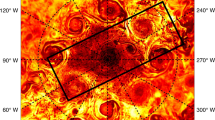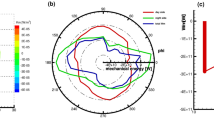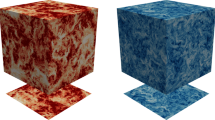Abstract
The Sun rotates differentially with a fast equator and slow pole1. Convection in the solar interior is thought to maintain the differential rotation. However, although many numerical simulations have been conducted to reproduce the solar differential rotation2,3,4,5,6,7, previous high-resolution calculations with solar parameters fall into the antisolar (fast-pole) differential rotation regime. Consequently, we still do not know the true reason why the Sun has a fast-rotating equator. While the construction of the fast equator requires a strong rotational influence on the convection, the previous calculations have not been able to achieve the situation without any manipulations. The problem is called the convective conundrum8. The convection and the differential rotation in numerical simulations were different from the observations. Here, we show that a high-resolution calculation succeeds in reproducing the solar-like differential rotation. Our calculations indicate that the strong magnetic field generated by a small-scale dynamo has a significant impact on thermal convection. The successful reproduction of the differential rotation, convection and magnetic field achieved in our calculation is an essential step to understanding the cause of the most basic nature of solar activity, specifically, the 11 yr cycle of sunspot activity.
This is a preview of subscription content, access via your institution
Access options
Access Nature and 54 other Nature Portfolio journals
Get Nature+, our best-value online-access subscription
$29.99 / 30 days
cancel any time
Subscribe to this journal
Receive 12 digital issues and online access to articles
$119.00 per year
only $9.92 per issue
Buy this article
- Purchase on Springer Link
- Instant access to full article PDF
Prices may be subject to local taxes which are calculated during checkout




Similar content being viewed by others
Data availability
The data generated, analysed and presented in this study are available at https://doi.org/10.5281/zenodo.5003258.
References
Schou, J. et al. Helioseismic studies of differential rotation in the solar envelope by the Solar Oscillations Investigation using the Michelson Doppler Imager. Astrophys. J. 505, 390–417 (1998).
Miesch, M. S. et al. Three-dimensional spherical simulations of solar convection. I. Differential rotation and pattern evolution achieved with laminar and turbulent states. Astrophys. J. 532, 593–615 (2000).
Brown, B. P., Browning, M. K., Brun, A. S., Miesch, M. S. & Toomre, J. Rapidly rotating suns and active nests of convection. Astrophys. J. 689, 1354–1372 (2008).
Nelson, N. J., Brown, B. P., Brun, A. S., Miesch, M. S. & Toomre, J. Magnetic wreaths and cycles in convective dynamos. Astrophys. J. 762, 73 (2013).
Hotta, H., Rempel, M. & Yokoyama, T. High-resolution calculation of the solar global convection with the reduced speed of sound technique. II. Near surface shear layer with the rotation. Astrophys. J. 798, 51 (2015).
Hotta, H., Rempel, M. & Yokoyama, T. Large-scale magnetic fields at high Reynolds numbers in magnetohydrodynamic simulations. Science 351, 1427–1430 (2016).
Hotta, H. Breaking Taylor–Proudman balance by magnetic fields in stellar convection zones. Astrophys. J. 860, L24 (2018).
O’Mara, B., Miesch, M. S., Featherstone, N. A. & Augustson, K. C. Velocity amplitudes in global convection simulations: the role of the Prandtl number and near-surface driving. Adv. Space Res. 58, 1475–1489 (2016).
Kageyama, A. & Sato, T. ‘Yin–Yang grid’: an overset grid in spherical geometry. Geochem. Geophys. Geosystems 5, Q09005 (2004).
Christensen-Dalsgaard, J. et al. The current state of solar modeling. Science 272, 1286–1292 (1996).
Miesch, M. S., Brun, A. S. & Toomre, J. Solar differential rotation influenced by latitudinal entropy variations in the tachocline. Astrophys. J. 641, 618–625 (2006).
Fan, Y. & Fang, F. A simulation of convective dynamo in the solar convective envelope: maintenance of the solar-like differential rotation and emerging flux. Astrophys. J. 789, 35 (2014).
Hotta, H., Rempel, M. & Yokoyama, T. Efficient small-scale dynamo in the solar convection zone. Astrophys. J. 803, 42 (2015).
Hanasoge, S. M., Duvall, T. L. & Sreenivasan, K. R. Anomalously weak solar convection. Proc. Natl Acad. Sci. USA 109, 11928–11932 (2012).
Hotta, H., Iijima, H. & Kusano, K. Weak influence of near-surface layer on solar deep convection zone revealed by comprehensive simulation from base to surface. Sci. Adv. 5, eaau2307 (2019).
Hotta, H. & Iijima, H. On rising magnetic flux tube and formation of sunspots in a deep domain. Mon. Not. R. Astron. Soc. 494, 2523–2537 (2020).
Hotta, H., Rempel, M., Yokoyama, T., Iida, Y. & Fan, Y. Numerical calculation of convection with reduced speed of sound technique. Astron. Astrophys. 539, A30 (2012).
Hotta, H., Rempel, M. & Yokoyama, T. High-resolution calculations of the solar global convection with the reduced speed of sound technique. I. The structure of the convection and the magnetic field without the rotation. Astrophys. J. 786, 24 (2014).
Rempel, M. Numerical simulations of quiet Sun magnetism: on the contribution from a small-scale dynamo. Astrophys. J. 789, 132 (2014).
Acknowledgements
We thank T. Yokoyama, R. Shimada and T. Hanawa for comments on the manuscript. The results were obtained using the supercomputer Fugaku provided by the RIKEN Center for Computational Science, the supercomputer Flow at Nagoya University and the Cray XC50 provided by the Center for Computational Astrophysics, National Astronomical Observatory of Japan. This work was supported by MEXT/JSPS KAKENHI (grants JP20K14510—principal investigator (PI) H.H., JP21H04492—PI K.K., JP21H01124—PI T. Yokoyama—and JP21H04497—PI H. Miayahara) and MEXT as a Program for Promoting Research on the Supercomputer Fugaku (Toward a unified view of the universe: from large-scale structures to planets, grant 20351188—PI J. Makino).
Author information
Authors and Affiliations
Contributions
H.H. contributed to the design of the project, developed the numerical code, carried out simulations, performed analysis and wrote the first draft of the paper. K.K. contributed to the design of the project, interpretation of the result and writing of the final draft.
Corresponding author
Ethics declarations
Competing interests
The authors declare no competing interests.
Additional information
Peer review information Nature Astronomy thanks Yuhong Fan, Juri Toomre and the other, anonymous, reviewer(s) for their contribution to the peer review of this work.
Publisher’s note Springer Nature remains neutral with regard to jurisdictional claims in published maps and institutional affiliations.
Supplementary information
Supplementary Information
Supplementary Figs. 1–4 and Discussion.
Supplementary Video
Overall structure of convection and magnetic field. Left, right: the radial velocity and the radial magnetic field at r = 0.9R☉, respectively, where R☉ is the solar radius.
Rights and permissions
About this article
Cite this article
Hotta, H., Kusano, K. Solar differential rotation reproduced with high-resolution simulation. Nat Astron 5, 1100–1102 (2021). https://doi.org/10.1038/s41550-021-01459-0
Received:
Accepted:
Published:
Issue Date:
DOI: https://doi.org/10.1038/s41550-021-01459-0
This article is cited by
-
Numerical evidence for a small-scale dynamo approaching solar magnetic Prandtl numbers
Nature Astronomy (2023)
-
Small-Scale Dynamos: From Idealized Models to Solar and Stellar Applications
Space Science Reviews (2023)
-
Two Populations of Sunspot Groups and Their Meridional Motions
Solar Physics (2023)
-
Evolution of Solar and Stellar Dynamo Theory
Space Science Reviews (2023)
-
Simulations of Solar and Stellar Dynamos and Their Theoretical Interpretation
Space Science Reviews (2023)



